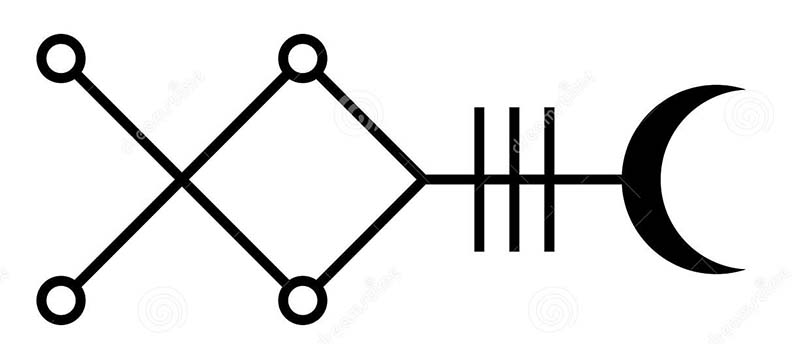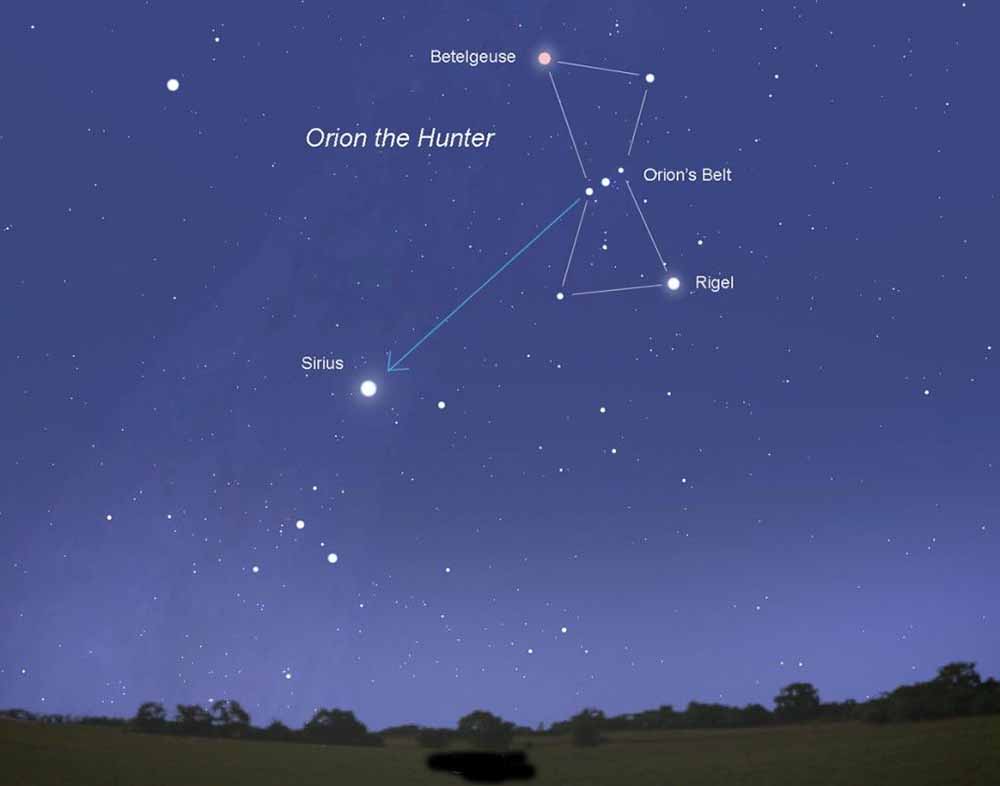

Sirius is the brightest star in the night sky. With a visual apparent magnitude of -1.46, it is almost twice as bright as Canopus, the next brightest star.
The name "Sirius" is derived from the Ancient Greek Seirios ("glowing" or "scorcher"). The star has the Bayer designation Alpha Canis Majoris. What the naked eye perceives as a single star is actually a binary star system, consisting of a white main sequence star of spectral type A1V, termed Sirius A, and a faint white dwarf companion of spectral type DA2, termed Sirius B. The distance separating Sirius A from its companion varies between 8.1 and 31.5 AU.
Sirius appears bright because of both its intrinsic luminosity and its proximity to Earth. At a distance of 2.6 parsecs (the Sirius system is one of Earth's near neighbors. Sirius A is about twice as massive as the Sun and has an absolute visual magnitude of 1.42. It is 25 times more luminous than the Sun but has a significantly lower luminosity than other bright stars such as Canopus or Rigel.
The system is between 200 and 300 million years old. It was originally composed of two bright bluish stars. The more massive of these, Sirius B, consumed its resources and became a red giant before shedding its outer layers and collapsing into its current state as a white dwarf around 120 million years ago.
Sirius can be seen from almost every inhabited region of the Earth's surface (those living north of 73.284 degrees cannot see it) and, in the Northern Hemisphere, is known as a vertex of the Winter Triangle. The best time of year to view it is around January 1, when it reaches the meridian at midnight. Under the right conditions, Sirius can be observed in daylight with the naked eye. Ideally the sky must be very clear, with the observer at a high altitude, the star passing overhead, and the sun low down on the horizon.
Sirius is also known colloquially as the "Dog Star", reflecting its prominence in its constellation, Canis Major (Big Dog). The heliacal rising of Sirius marked the flooding of the Nile in Ancient Egypt and the "dog days" of summer for the ancient Greeks, while to the Polynesians it marked winter. Read more
Physical reality is created by electromagnetic energy grids.
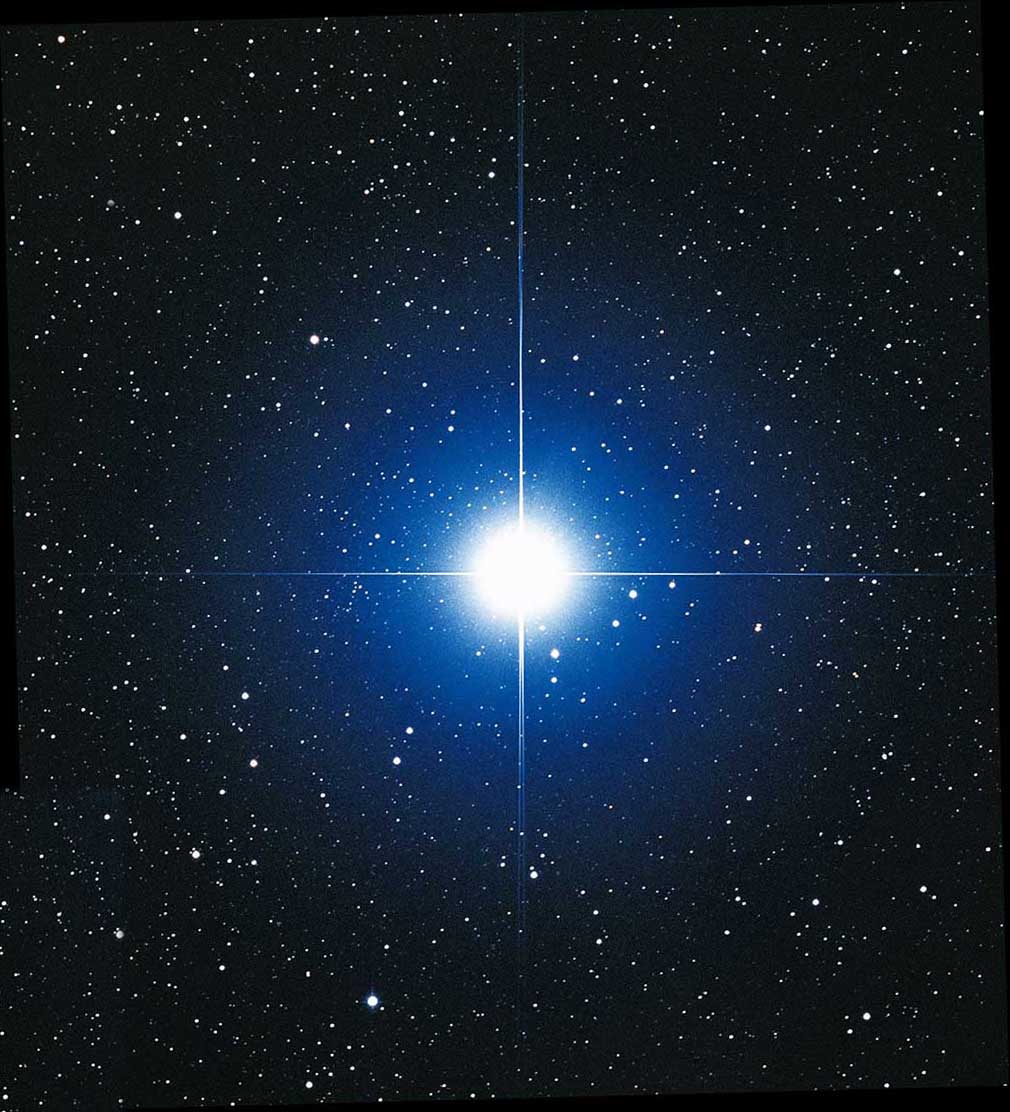
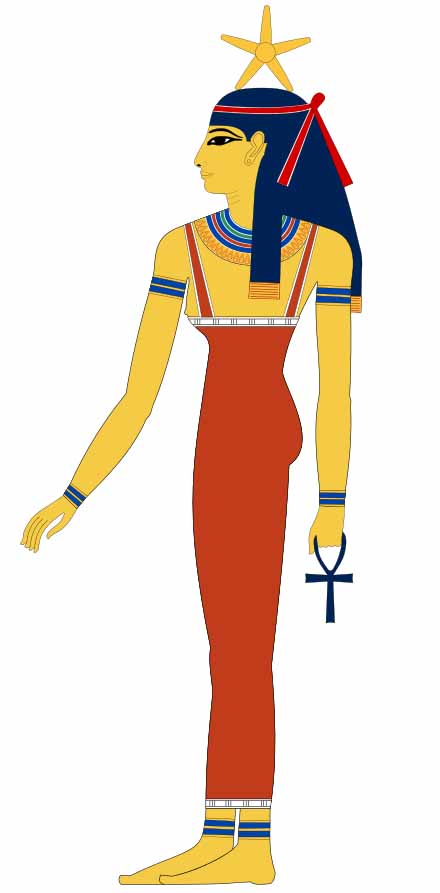
Isis - Sopdet Depictions
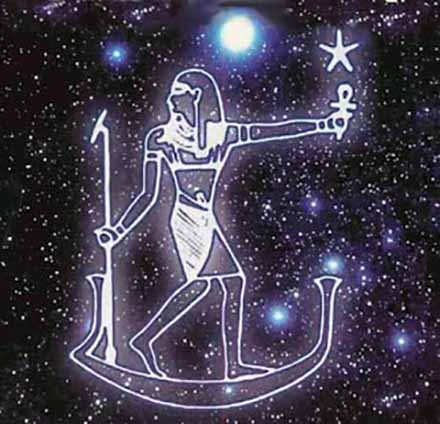
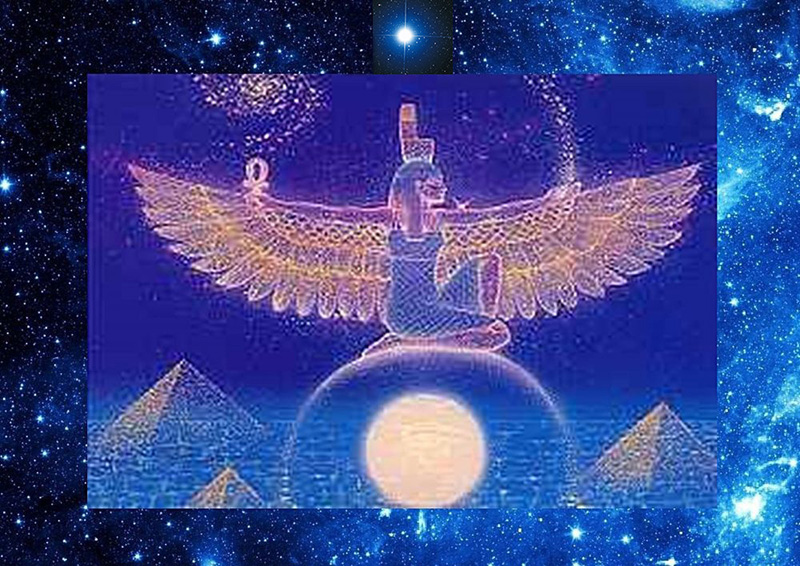
In Ancient Egyptian Mythology

Sirius, Queen's Chamber (Feminine), Pleiades (Sister Stars) - Orion Kings Chamber
Thuban was the pole star when the pyramids allegedly were built and the Simulation began.

Allegedly ancient aliens from Sirius were blue
their descendants thought of as blue-bloods or royalty.
Sirius was both the most important star of ancient Egyptian astronomy, and one of the Decans (star groups into which the night sky was divided, with each group appearing for ten days annually). The heliacal rising (the first night that Sirius is seen, just before dawn) was noticed every year during July. Early Egyptians used this to mark the start of the New Year ('The Opening of the Year'). It was celebrated with a festival known as 'The Coming of Sopdet'.
As early as the 1st Dynasty, Sophis was known as 'the bringer of the new year and the Nile flood'. When Sirius appeared in the sky each year, the Nile generally started to flood and bring fertility to the land. The ancient Egyptians connected the two events, and so Sopdet took on the aspects of a goddess of not only the star and of the inundation, but of the fertility that came to the land of Egypt with the flood. The flood and the rising of Sirius also marked the ancient Egyptian New Year, and so she also was thought of as a goddess of the New Year.
Her aspect of being a fertility goddess was not just linked to the Nile. By the Middle Kingdom, she was believed to be a mother goddess, and a nurse goddess, changing her from a goddess of agriculture to a goddess of motherhood. This probably was due to her strong connection with the mother-goddess Isis. Not just a goddess of the waters of the inundation, Sopdet had another link with water - she was believed to cleanse the pharaoh in the afterlife. It is interesting to note that the embalming of the dead took seventy days - the same amount of time that Sirius was not seen in the sky, before it's yearly rising. She was a goddess of fertility to both the living and the dead.
In the Pyramid Texts, she is the goddess who prepares yearly sustenance for the pharaoh, 'in this her name of "Year"'. She is also thought to be a guide in the afterlife for the pharaoh, letting him fly into the sky to join the gods, showing him 'goodly roads' in the Field of Reeds and helping him become one of the imperishable stars. She was thought to be living on the horizon, encircled by the Duat. Paralleling the story of Osiris and Isis, the pharaoh was believed to have had a child with Sopdet.
In the Sumerian Civilization, predating the Egyptians, their epic poem Epic of Gilgamesh describes a dream of Gilgamesh where the hero is drawn irresistibly to a heavy star that cannot be lifted despite immense effort.
This star descends from heaven to him and is described as having a very 'potent essence' and being "the God of heaven". Gilgamesh had for his companions, 50 oarsmen in the great ship, Argo, a constellation bordering Canis Major, where Sirius is found.
The Dogon describe this 'star' specifically as having a circle of reddish rays around it, and this circle of rays is 'like a spot spreading' but remaining the same size. The Dogon are a West African tribe who have known about, and worshipped, Sirius A and its twin the invisible star Sirius B, for the past 5,000 years. They are have also been aware of the planets circle the sun in elliptical orbits, the four moons of Jupiter and the rings of Saturn.
They say that Sirius B is immensely heavy, invisible, very small, yet extremely powerful. Their understanding of the two stars' orbits coincides exactly with modern astronomical findings, yet was arrived at thousands of years before it was scientifically proven. They also claim that a third star Emme Ya - Sorghum Female - exists in the Sirius system. Larger and lighter than Sirius B, this star revolves around Sirius A as well.
The Dogon also believe that approximately 5,000 years ago, Amphibious Gods, called Nommo, came to Earth in three legged space ships from the Sirius Star System. They have described perfectly the DNA pattern made by this elliptical orbit created by the two stars as they rotate make around each other. They believe Sirius to be the axis of the universe, and from it all matter and all souls are produced in a great spiral motion.
The ancient Greeks observed that the appearance of Sirius heralded the hot and dry summer, and feared that it caused plants to wilt, men to weaken, and women to become aroused. Due to its brightness, Sirius would have been noted to twinkle more in the unsettled weather conditions of early summer.
To Greek observers, this signified certain emanations which caused its malignant influence. People suffering its effects were said to be astroboletosor "star-struck". It was described as "burning" or "flaming" in literature. The season following the star's appearance came to be known as the Dog Days of summer.
The inhabitants of the island of Ceos in the Aegean Sea would offer sacrifices to Sirius and Zeus to bring cooling breezes, and would await the reappearance of the star in summer. If it rose clear, it would portend good fortune; if it was misty or faint then it foretold (or emanated) pestilence.
Coins retrieved from the island from the 3rd century BC feature dogs or stars with emanating rays, highlighting Sirius' importance. The Romans celebrated the heliacal setting of Sirius around April 25, sacrificing a dog, along with incense, wine, and a sheep, to the goddess Robigo so that the star's emanations would not cause wheat rust on wheat crops that year.
Ptolemy of Alexandria mapped the stars in Books VII and VIII of his Almagest, in which he used Sirius as the location for the globe's central meridian. He curiously depicted it as one of six red-colored stars. The other five are class M and K stars, such as Arcturus and Betelgeuse.
In Chinese astronomy the star is known as the star of the "celestial wolf".
Several cultures also associated the star with a bow and arrows. The Ancient Chinese visualized a large bow and arrow across the southern sky, formed by the constellations of Puppis and Canis Major. In this, the arrow tip is pointed at the wolf Sirius.
A similar association is depicted at the Temple of Hathor in Dendera, where the goddess Satet has drawn her arrow at Hathor (Sirius). Known as "Tir", the star was portrayed as the arrow itself in later Persian culture.
The Quran mentions Sirius in Surah 53, An-Najm ("The Star"), of the Qur'an, where it is given the name (al-shi'raa.) The verse is "That He is the Lord of Sirius (the Mighty Star)." (53:49)
Just as the appearance of Sirius in the morning sky marked summer in Greece, so it marked the chilly onset of winter for the Maori, whose name Takurua described both the star and the season. Its culmination at the winter solstice was marked by celebration in Hawaii, where it was known as Ka'ulua, "Queen of Heaven". Many other Polynesian names have been recorded, including Tau-ua in the Marquesas Islands, Rehua in New Zealand, and Aa and Hoku-Kauopae in Hawaii.
Bright stars were important to the ancient Polynesians for navigation between the many islands and atolls of the Pacific Ocean. Low on the horizon, they acted as stellar compasses to assist mariners in charting courses to particular destinations. They also served as latitude markers; the declination of Sirius matches the latitude of the archipelago of Fiji at 17íS and thus passes directly over the islands each night.
Sirius served as the body of a "Great Bird" constellation called Manu, with Canopus as the southern wingtip and Procyon the northern wingtip, which divided the Polynesian night sky into two hemispheres.
Several cultures also associated the star with a bow and arrows. Many nations among the indigenous peoples of North America also associated Sirius with canines; the Seri and Tohono O'odham of the southwest note the star as a dog that follows mountain sheep, while the Blackfoot called it "Dog-face".
The Cherokee paired Sirius with Antares as a dog-star guardian of either end of the "Path of Souls". The Pawnee of Nebraska had several associations; the Wolf (Skidi) tribe knew it as the "Wolf Star", while other branches knew it as the "Coyote Star".
Hopi Prophecy states, When the Blue Star Kachina (Sirius) makes its appearance in the heavens, the Fifth World will emerge.
Further north, the Alaskan Inuit of the Bering Strait called it "Moon Dog".

The dog days of summer refers to the 40-day period from July 3-August 11. They were historically the period following the heliacal rising of the star system Sirius (known colloquially as the "Dog Star"), which Hellenistic astrology connected with heat, drought, sudden thunderstorms, lethargy, fever, mad dogs, and bad luck. They are now taken to be the hottest, most uncomfortable part of summer in the Northern Hemisphere.
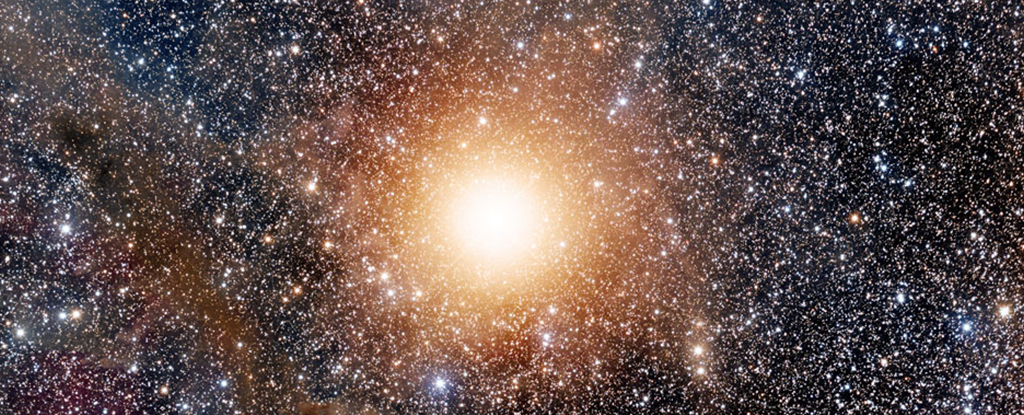
A Stunning Revelation Could Mean Betelgeuse Is Set to Blow
Science Alert - July 3, 2023

Orion is perhaps an alien home base or way station often associated with Osiris of Isis-Osiris Mythology. Many people believe Orion is "Home" with Betelgeuse a memory. Betelgeuse is a red supergiant star and the second-brightest in the constellation of Orion.
